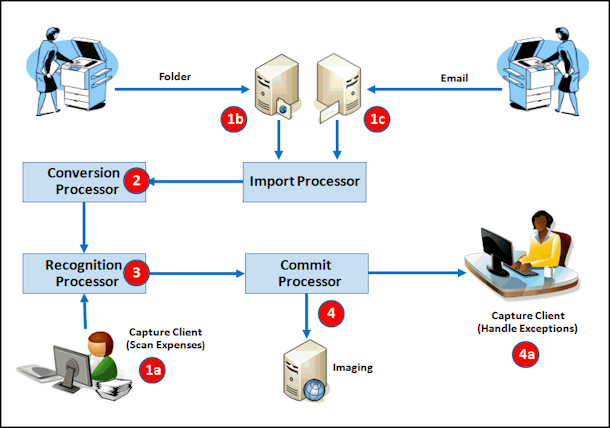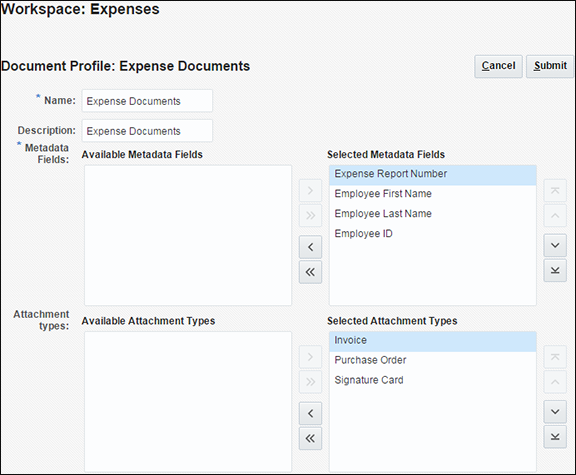10 Use Case: Processing Employee Expenses
Executive Summary
Use Case: The organization lacked an efficient method of receiving, capturing, and categorizing expense reports for sending on to approval workflow. Expenses were received in multiple ways, typically in paper form or emailed in various file formats. The substantial time the staff spent manually processing expenses resulted in high costs and payment delays.
Solution: Configure a Capture workspace that provides automated and manual processing paths for scanning and importing expenses, reading their bar codes, and committing them for further processing.
-
Capture client
-
Capture Recognition Processor
-
Capture Document Conversion Processor
-
Capture Import Processor
-
Capture Commit Processor
-
WebCenter Content: Imaging
-
Business and workflow applications (for example, Oracle E-Business Suite and Oracle Business Process Management)
This chapter contains the following sections:
10.1 Introduction to the Use Case
This use case illustrates configuring a Capture workspace for automated and manual capture, document conversion, bar code recognition, and commit of expense reports, as shown in Figure 10-1.
Assumptions
The use case makes several assumptions:
-
Employees initiate the process by creating an expense report, typically as part of a business application workflow. Creating an expense report automatically initiates the following processes:
-
Generates a cover sheet containing a bar code that identifies the expense report number.
-
Writes a database record that references the employee expense report number and links it to key employee values, such as name and employee ID.
-
-
Employees print the bar coded cover sheet, attach applicable expense receipts to it, and submit it.
-
For automated processing, employees scan their expenses cover sheet and receipts using a multi-function device, which sends them to a specified email account or network folder.
-
In cases where employees are unable to scan their reports, staffs receive them in paper format, and manually scan and index them.
-
Expense Process in Capture Workspace
-
Expense reports enter a Capture workspace through one of several manual or automated paths (numbers below correspond to highlighted numbers in Figure 10-1):
-
Capture Client: Using a client profile, an employee scans or imports expense reports. Because scanning in the client always creates image documents and the client can convert imported ones, these batches go directly to recognition (bar code) processing.
-
Folder: Employees scan their expense reports on multi-function devices (MFDs), saving them to a network folder. A folder-type Import Processor job imports them, then sends the batch to the Document Conversion Processor. If the MFD created PDF files instead of TIFF files during scanning, the Document Conversion Processor job will convert the PDF files to image format, which is needed for recognition processing.
-
Email: Employees scan their expense reports on MFDs. The MFD creates a PDF document, attaches it to an email message and sends the email to an expenses inbox monitored by the Import Processor. An email-type Import Processor job imports the message's attachments, then sends the batch to the Document Conversion Processor to convert the PDFs to image format for recognition processing.
-
-
A Document Conversion Processor job converts any non-image documents and attachments to image documents, merges them to a single document required for recognition processing, and sends the batch to the Recognition Processor. Employees may scan one or multiple expense reports that may exist in the email as an attachment per expense report or as one attachment with multiple expense reports. So, the Document Conversion Processor is configured to collapse all pages into a single image document to allow the Recognition Processor to organize the documents based on the detection of the expense report number bar code.
-
A Recognition Processor job organizes the batch into individual expense documents based on expense cover sheets it detects. It then assigns the bar code's value (in this case, an expense report number) to a required Capture metadata field, and that value is used to look up and populate remaining metadata fields.
-
The Commit Processor commits the indexed expense reports to Imaging for approval and processing.
-
A client user handles any expense report exceptions that fail commit, such as those that encountered bar code recognition issues.
-
10.2 Implementing the Use Case
This section describes how to configure Capture for the expense processing use case.
Part I: Configuring Manual Expense Processing
Part II: Configuring Automated Expense Processing
10.2.1 Task 1: Use Case Prerequisites
To work with this use case, you need the following:
-
TIFF or PDF files.
-
TIFF image files, preferably multiple page, with a cover sheet containing a bar code. For example, you might use expense reports with a Code 128 bar code on each report's cover sheet.
-
PDF files, also multiple page, with a bar code on their cover sheets.
-
-
A JDBC database connection for configuring a database lookup, as described in Task 3: Configure a Database Lookup to Populate Capture Fields. The lookup will search the database for an expense report number and return employee information.
-
A location from which to import expense reports, as described in Task 9: Configure Folder Import Processing. For example, this might be a shared folder on your network, such as
\\FileServer\Expenses\Import. -
An email account from which to import expense report emails and attachments, as described in Task 10: Configure Email Import Processing.
-
A WebCenter Content: Imaging instance to which to commit processed expense documents, as described in Configure Committing to Imaging. To test the configuration when no Imaging instance is available, you can configure a text file commit to a shared network folder such as
\\FileServer\Expenses\Commit, as described in Configure Committing to a Folder (for Testing).
10.2.2 Task 2: Create an Expenses Workspace and Elements
Begin by creating the structure and building blocks for the expenses use case. In the workspace you create, you will add the following elements:
-
Metadata fields to contain expense document values
-
A document profile that identifies the expense document metadata fields
-
A database lookup to populate metadata fields
-
A client profile for manually scanning or importing expense reports. This client profile also allows you to test your workspace settings. The importing option is useful when you do not have a scanner available.
To create a workspace and elements:
-
In the Capture workspaces pane, add a workspace (for example,
Expenses). Select the new workspace. -
On the Metadata tab, add metadata fields such as the following:
-
Expense Report Number (Alpha Numeric, Required)
-
Employee First Name (Alpha Numeric)
-
Employee Last Name (Alpha Numeric)
-
Employee ID (Alpha Numeric)
Figure 10-2 Creating Metadata Fields in the New Workspace

Description of "Figure 10-2 Creating Metadata Fields in the New Workspace" -
-
On the Classification tab, create attachment types such as the following:
-
Invoice (Required)
-
Purchase Order
-
Signature Card
-
-
On the Classification tab, create a document profile (for example,
Expense Documents). Add the metadata fields and order them so they display in the client as follows:-
Expense Report Number
-
Employee First Name
-
Employee Last Name
-
Employee ID
Add the attachment types and order them so they display in the client as follows:-
Invoice
-
Purchase Order
-
Signature Card
-
10.2.3 Task 3: Configure a Database Lookup to Populate Capture Fields
In this section, configure a lookup that searches a database for an expense report number and returns the associated employee's ID and full name from the expenses record.
-
In the Metadata tab, click the Add button in the Database Lookup Profiles table.
-
Select settings on the General Settings train stop of the Database Lookup screen.
-
In the Database Lookup Name field, enter a name such as
Employee Lookup. -
In the JNDI Name field, enter a database connection (for example,
jdbc/lob). Click Connect. If successful, Status changes to Connected: connection name.
-
-
On the Search Fields train stop, configure the lookup to search on the expense report number field.
-
Click the Add button in the Search Field Definitions table.
-
In the Search Field Settings window, select Expense Report Number as the Capture Field to search.
-
Select the Schema, Table, and Database Field to search. (For this exercise, you can use nearly any data for example purposes.) Click OK.
-
-
On the Return Fields train stop, configure the lookup to return database values based on the search results.
Notice that Expense Report Number is automatically selected in the Search Field option in the Return Field Definitions table's heading.
-
Click the Add button.
-
In the Return Field Settings window, select Employee ID as the Capture Field to be populated. Select the Database Field (from the previously selected schema and table) from which to return a value. Click OK.
-
Add another return field, selecting Employee First Name as the Capture Field to be populated and the database field whose value will populate the Capture field. Repeat to add a final return field for the Employee Last Name Capture field.
-
If needed, use the up/down arrow buttons to reorder the return fields as shown in Figure 10-4. The fields will be listed in this order left to right in client lookup results.
Figure 10-4 Configuring Database Lookup Return Fields for a Selected Search Field
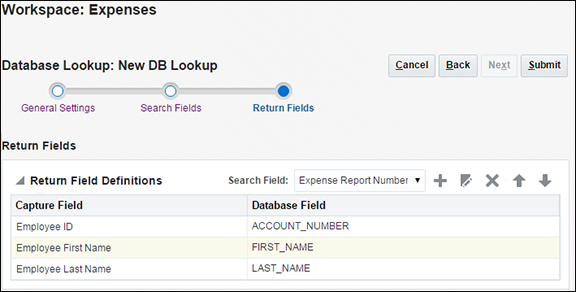
Description of "Figure 10-4 Configuring Database Lookup Return Fields for a Selected Search Field"
-
-
Click Submit to save the lookup.
10.2.4 Task 4: Configure Client Scanning of Expenses
Configure a client profile that client users can use to manually scan or import expense documents.
-
On the Capture tab, click the Add button in the Client Profiles table.
-
Configure settings on the General Settings train stop.
-
In the Profile Type field, choose 2 - Capture and Index.
-
In the Profile Name field, enter a name such as
Scan Expenses. -
In the Batch Prefix field, enter a prefix such as
SCANEXP.
-
-
Configure settings on the Image Settings train stop.
-
In the Default DPI field, select 300.
-
In the Non-Image File Import Action field, select Convert to Image Format. This will allow you to import PDF (non-image) files and Capture will convert them within the client without requiring the use of the Document Conversion Processor.
-
In the DPI field under Non-Image Conversion options, select 300.
-
-
Complete settings on the Document Indexing Settings train stop.
-
In the Document Creation Option field, select 3 - Variable Number of Pages.
-
In the Database Lookup Profile field, select the database lookup you created in Task 3: Configure a Database Lookup to Populate Capture Fields (for example,
Employee Lookup). -
In the Document Profiles field, select the profile you created (for example,
Expense Documents).Figure 10-5 Configuring a Client Profile for Capturing Expense Documents
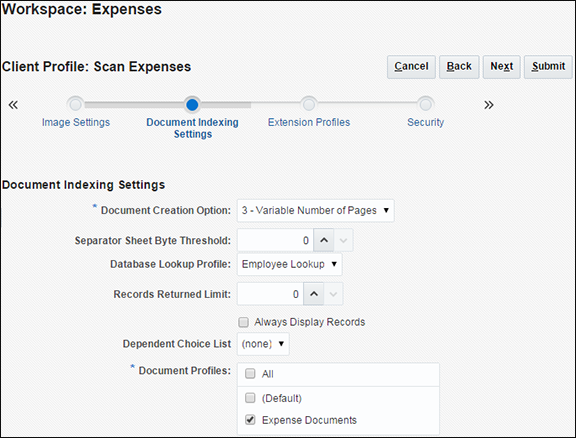
Description of "Figure 10-5 Configuring a Client Profile for Capturing Expense Documents"
-
-
On the Security train stop, assign yourself to the client profile.
-
On the Post Processing train stop, click Add in the Available Release Processes table to add a release process. In the Release Process Settings window, enter a name for the release process such as
commit. Select Commit Processor in the Batch Processor field. Initially, we will test document committing. Later, we will change the client profile to release batches to the Recognition Processor. -
Click Submit to save the client profile.
10.2.5 Task 5: Configure Commit Processing
In this section, you configure commit processing. In a typical expenses scenario, expenses would be committed to Imaging for workflow processing. But for verification purposes or if you do not have an Imaging system available, you may want to configure a text file commit profile instead. You can configure one or both of the following profiles:
10.2.5.1 Configure Committing to Imaging
-
On the Commit tab, click the Add button in the Commit Profiles table.
-
Complete settings on the General Settings train stop.
-
In the Commit Profile Name field, enter a name (
Commit to Imaging). -
In the Commit Driver field, select WebCenter Content Imaging.
-
In the Document Output Format field, select PDF Searchable.
-
In the Restrict Commit to Document Profiles field, select the Expense Documents profile.
Figure 10-6 Configuring a Commit Profile for Committing to Imaging
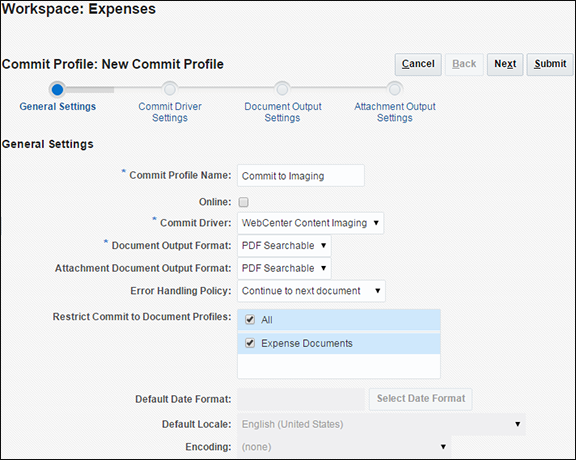
Description of "Figure 10-6 Configuring a Commit Profile for Committing to Imaging" -
-
Complete settings on the Commit Driver Settings train stop. These settings are specific to the Imaging commit driver you selected in step 2.b.
-
On the Login tab, enter a User ID, Password, and Imaging WebService URL. Click Connect. The URL uses the following format:
http://hostname:port/imaging/ws -
On the General tab, select Direct Commit.
-
On the Field Mappings tab, map Capture fields to fields in the selected Imaging application.
Select an Imaging application to which to write metadata values in the Imaging Application field. In the table, select an Imaging field to map and click the Edit button. Select a Capture field to map its value to the selected Imaging field.
-
-
Click Submit to save the commit profile.
10.2.5.2 Configure Committing to a Folder (for Testing)
Follow these steps to commit expense reports to a document folder for testing purposes.
-
On the Commit tab, click the Add button in the Commit Profiles table.
-
Complete settings on the General Settings train stop.
-
In the Commit Profile Name field, enter a name (
Commit to Text). -
In the Commit Driver field, select Text File.
-
In the Document Output Format field, select TIFF Multi-Page.
-
In the Restrict Commit to Document Profiles field, select the Expense Documents profile.
Figure 10-7 Configuring a Commit Profile for Committing Documents to a Network Folder
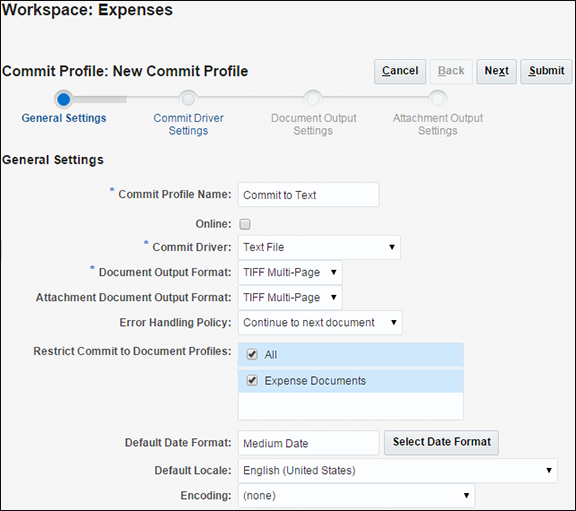
Description of "Figure 10-7 Configuring a Commit Profile for Committing Documents to a Network Folder"
-
-
Complete settings on the Commit Driver Settings train stop. These settings are specific to the commit text driver you selected in step 2.b.
-
In the Commit Text File Folder field, enter a location to write commit text files. This will enable you to view one or more text files after commit and verify the expense report number and the database lookup return fields.
Either specify a folder on the Capture server or a network path accessible from the Capture server. For this example, you might specify a shared folder on your system. If the Capture server is running on Windows, you might specify a UNC path to a network share, such as
\\FileServer\Expenses\Commit.In the File Prefix field, enter
TEXT_FILE.In the File Extension field, enter
txt. -
On the Document Folder tab, enter a location in the Document Folder field to write the expense files. For testing purposes, this might be a shared folder on your network, such as
\\FileServer\Expenses\Import.Select the Create a folder per committed batch field.
-
On the Formatting tab, complete settings.
In the Fields to Include in Commit Text File field, move the file name and metadata fields from the Available Fields list to the Selected Fields list.
-
On the Document File Naming tab, complete settings.
Select the Name document file based on metadata field values field, then move Expense Report Number to the Selected Fields list.
-
-
Click Submit to save the commit profile.
10.2.6 Task 6: Verify Manual Processing
In this section, verify the settings and profiles you configured.
-
Start the Capture client.
Each time you make changes to a client profile in the workspace console, you need to sign out and back in to the Capture client to see the changes reflected.
-
Select the client profile you created (for example, Scan Expenses) in the Client Profile field in the upper left of the client window.
-
Capture one or more expense reports.
-
If scanning expenses, the client will create one document per batch, because you chose the Variable Number of Pages option but did not insert blank separator sheets between documents. (Document separation will occur later.)
-
If importing expenses, select the Create one document per import file option when prompted and select one file only. You can import PDF files in addition to TIFF files, because you selected Convert to Image Format in the Non-Image File Import Action field in Task 4: Configure Client Scanning of Expenses.
-
-
Expand the new batch. Select the document and organize it into separate expense documents.
If you scanned multiple expenses, you must manually organize the single document into multiple expense documents. (In a later section, you will configure the Recognition Processor to automatically organize documents based on detected bar-coded cover sheets.)
Use the down arrow key to proceed through the images until you reach the first page of a new expense document. Click the Create New Document button from the document toolbar. A new document separation appears in the thumbnail display.
Figure 10-8 As a Client User, Separating a Batch into Expense Documents
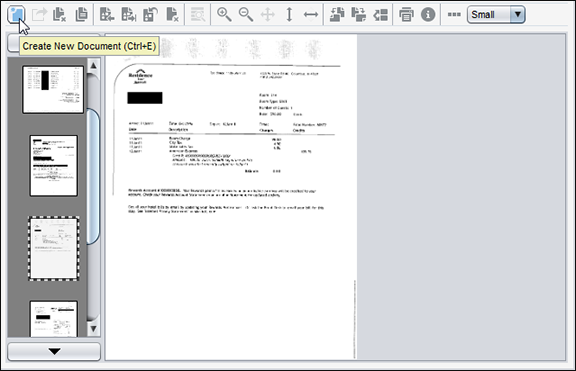
Description of "Figure 10-8 As a Client User, Separating a Batch into Expense Documents" -
Use the database lookup to search by expense report number and return employee ID and name metadata values.
The metadata pane displays in the lower left pane. The Expense Report Number field name is prefaced with an asterisk to indicate that it is required. To successfully commit a document, all required fields must contain a value. (In a later section, the Recognition Processor will automatically read the bar code value and populate the fields.)
-
On a document's cover sheet, zoom in to view the expense report number.
Zoom in by left-clicking, dragging a rectangle around the area to zoom, and releasing.
Figure 10-9 As a Client User, Zooming In and Looking Up Values

Description of "Figure 10-9 As a Client User, Zooming In and Looking Up Values" -
In the metadata pane, click the Expense Report Number field.
The name of the selected field displays in blue. Because you configured the lookup to search using this field, the Database Lookup button becomes available on the document pane's toolbar.
-
Enter a value to search for (optional), then click the Database Lookup button.
In a typical scenario, the user would enter the expense report number, the lookup would find a matching value and then populate Capture metadata fields with the employee ID, first name, and last name values returned from the selected database record.
If you are testing the configuration, you can leave the field blank to return all values found. In that case, the Database Lookup Results window displays. Select a record in the window and the Capture metadata fields are populated with the employee ID, first name, and last name values returned from the selected database record.
Figure 10-10 As a Client User, Populating Metadata Fields Using the Database Lookup
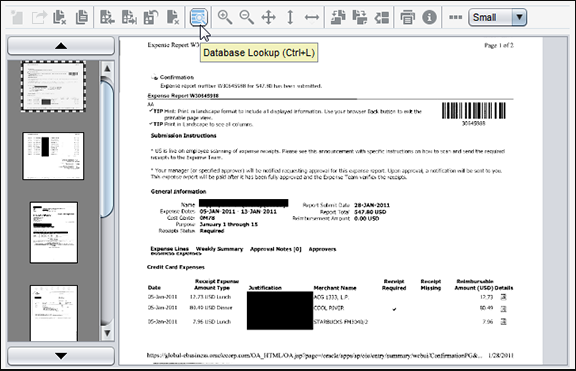
Description of "Figure 10-10 As a Client User, Populating Metadata Fields Using the Database Lookup"
-
-
Complete indexing the batch's documents.
-
Click the Release Batch button to release the batch.
Notice that a progress bar indicates the release status as the batch is synchronized with the Capture server. When clicking the Refresh Batch List button, the batch either disappears from the batch pane (indicating it was successfully committed) or remains with an error. For more information about errors, see Task 11: Configure Exception Handling.
-
Open the commit folder you specified in Task 5: Configure Commit Processing. View one or more text files and verify the expense report number and the database lookup return fields.
10.2.7 Task 7: Configure Document Conversion Processing
In this section, configure a Document Conversion Processor job to convert documents from PDF to TIFF format.
-
On the Processing tab, click the Add button in the Document Conversion Processor Jobs table.
-
Complete settings on the Document Selection train stop.
-
In the Name field, enter a name (for example,
Convert PDFs). -
In the Documents to Convert field, choose Selected non-image documents. Enter
*.pdfin the File Name Filter field. In the Restrict to Document Profiles field, select the profile you created (for example, Expense Documents).Figure 10-11 Configuring a Document Conversion Processor Job to Convert PDF Files to TIFF Format
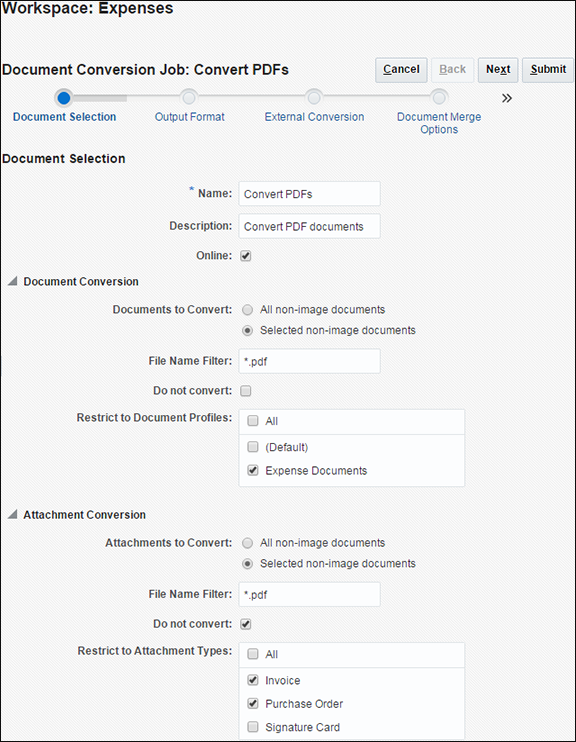
Description of "Figure 10-11 Configuring a Document Conversion Processor Job to Convert PDF Files to TIFF Format" -
In the Attachments to Convert field, choose Selected non-image documents. Enter
*.pdfin the File Name Filter field. In the Restrict to Attachment Types field, select the attachment types you created (for example, Invoice and Purchase Order).
-
-
On the Output Format train stop, select TIFF: black and white in the Output Image Format field and 300 in the DPI field.
-
Optionally, you can specify settings for using an external conversion program on the External Conversion train stop.
-
Enter
*.pdfin the File Name Filter(s) field. -
Specify the full path and file name of the external conversion program in the External Conversion Program field.
-
In the Command Line Parameters field enter
<Input File>to substitute the file name of the input file and enter<Output File>to substitute the file name of the output file. During document conversion process, these literal strings are replaced with the actual values before being passed on to the external conversion program.<Input File>is the name of the source document file to convert (includes the full path and the file name).<Output File>is the multiple page TIFF file to be generated by the external conversion program (includes the full path and the file name). The output file name is always the same as the input file name path and file name appended with “.TIF”. For example, if the input file name isC:\Users \captureuser\AppData\Local\Temp\1\Sample.PDF, then the output file name will beC:\Users\captureuser\AppData\Local\Temp \1\Sample.PDF.TIF.
-
-
On the Document Merge Options train stop, select Merge all documents in the Batch Merge Option field. This will ensure that the batch will contain one document only, which is required for the recognition processing that will follow conversion.
In the Source Attachments field, select the Include Attachments matching Document Profile Attachment Types option.
-
Click Submit to save the Document Conversion Processor job.
-
Configure batches to flow from the client to the Document Conversion Processor job.
-
On the Capture tab, edit the Scan Expenses client profile you created in Task 4: Configure Client Scanning of Expenses. On its Image Settings train stop, change the Non-Image File Import Action field to Import in Native Format.
-
On its Post-Processing train stop, edit the release process you created and select Document Conversion Processor in the Batch Processor field, and select the Convert PDFs job in the Batch Processor Job field.
-
Click Submit to save the client profile. When you release a batch from the client, the batch will go to document conversion processing.
-
-
Verify that the Document Conversion Processor is converting non-image files and merging them into a single document.
-
On the Processing tab, in the Document Conversion Jobs table, edit the Convert PDFs job you created in this section. On its Post-Processing train stop, change the Batch Processor field to None.
-
Click Submit to save the Document Conversion Job.
-
Sign out of the client and back in.
-
Import several PDF expense documents with bar codes, selecting the Create one document per import file option.
-
Release the batch. The batch icon changes to a gear to indicate processing. Click the Refresh Batch List icon, multiple times if needed.
-
When the batch icon changes from processing to unlocked, expand the batch and see a single document.
-
10.2.8 Task 8: Configure Recognition Processing
Now that you can manually capture and index expense documents in the workspace, begin configuring automated processing by creating a Recognition Processor job in this section. The job will read expense report bar code values on the batch pages, organize the documents, and assign metadata values. To test the job, you will need documents with bar code values to capture.
-
On the Processing tab of Expenses workspace, click the Add button in the Recognition Processor Jobs table.
-
On the General Settings train stop, enter a name (for example,
Expense Reports) in the Recognition Job Name field. -
On the Bar Code Recognition train stop, select the bar code engine to use, symbology for the bar codes you will scan (for example, choose Code 128 or equivalent), and specify settings specific to recognition and processing of bar codes.
-
Create a definition on the Bar Code Definition train stop. For example, the steps below create a definition that uses a mask validation rule to look for an 8 digit bar code.
-
Click the Add button in the Bar Code Definitions table.
-
In the Bar Code Definition window, enter a name such as
Expense Report #in the Name field. -
In the Validation Rule field, specify how to validate the bar code. For example, select Mask to create a mask validation definition. For more information about masks, see Configuring a Metadata Field's Input Mask.
-
Complete the validation-specific field or fields that display, then click OK. For example, for a mask definition, enter a mask in the Mask field that displays. You might enter a mask of 8 # signs to identify 8 digits:
########Figure 10-12 Expense Report Bar Code Definition
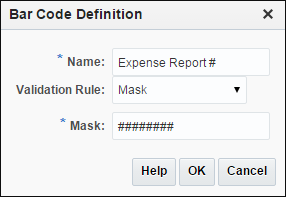
Description of "Figure 10-12 Expense Report Bar Code Definition"
-
-
On the Document Organization train stop, leave the default Separator pages option selected.
In step 7, you will define the separator page. This will automate document organization for batches with bar coded separator sheets, as shown in Figure 10-1.
-
On the Document Profile train stop, select the Expense Documents profile you created in the Default Document Profile field.
Since all of the documents in a batch are expected to be expense reports and receipts, select the Expense Documents profile.
-
On the Document Processing train stop, configure an expense cover sheet separator page.
-
Click the Configure button.
-
On the Separator Page Definition screen, enter a name in the Name field (for example,
Expense Cover Sheet). -
Click the Add button in the Rules table.
-
In the Separator Page Rule window, enter a name (for example,
Expense Separator Rule) in the Rule Name field. -
In the Bar Code field, select the bar code definition you created (Expense Report #). Click OK, then Submit to complete the separator page definition.
Figure 10-13 Configuring a Separator Page to Organize the Single Document Into Expense Documents
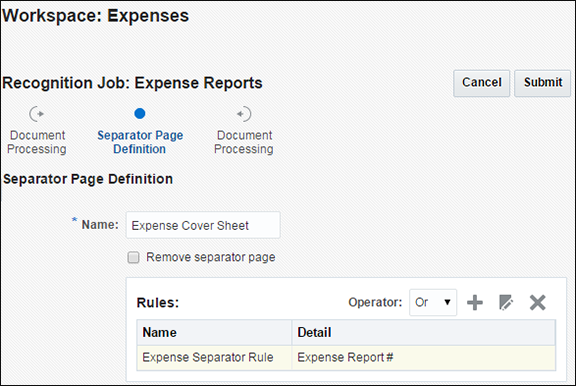
Description of "Figure 10-13 Configuring a Separator Page to Organize the Single Document Into Expense Documents" -
In the Source Document Attachments field, select the Include attachments with matching Document Profile attachment types option.
-
-
On the Fields train stop, configure the bar code value to populate the Expense Report Number metadata field.
-
Select the Expense Report Number row in the Fields table and click the Edit button.
-
In the Edit Recognition Job Field window, select Bar Code in the Auto Populate With field, and select Expense Report # in the Bar Code field. Click OK.
Figure 10-14 Configuring the Bar Code Value to Populate a Capture Metadata Field

Description of "Figure 10-14 Configuring the Bar Code Value to Populate a Capture Metadata Field"
-
-
On the Database Lookup train stop, set a database lookup to populate the remaining metadata fields.
-
In the Using field, select Field Value.
-
In the Field Name field, select Expense Report Number.
-
In the Database Lookup Profile field, select Employee Lookup.
-
Select Expense Report Number as the Database Search Field.
Figure 10-15 Configuring the Database Lookup to Populate Capture Metadata Fields
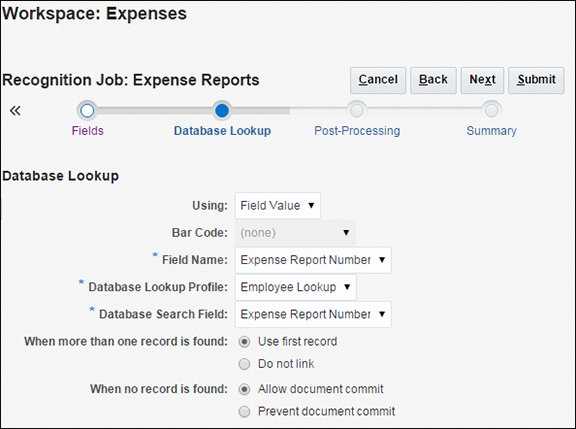
Description of "Figure 10-15 Configuring the Database Lookup to Populate Capture Metadata Fields" -
-
On the Post-Processing train stop, select Commit Processor in the Batch Processor field under When there is no system error options. As shown in Figure 10-1, batches will flow from this Recognition Processor job to the Commit Processor.
-
Click Submit to save the Recognition Processor job.
-
Configure batches to flow from the Document Conversion Processor job to the Recognition Processor job.
-
On the Processing tab, in the Document Conversion Jobs table, edit the Convert PDFs job you created in Task 7: Configure Document Conversion Processing.
-
Under the When there is no system error options on the Post-Processing train stop, select Recognition Processor in the Batch Processor field, and select the Expense Reports job in the Batch Processor Job field.
-
Click Submit to save the Document Conversion Processor job. When you release from the client, the batch will go to document conversion processing, then automatically to recognition processing.
-
-
Verify the Recognition Processor job.
-
Temporarily deactivate the commit profile, so that you can see the Recognition Processor job's results in the client. On the Commit tab, select the Imaging and/or folder commit profile and click the Toggle Online/Offline button.
-
Sign out of the client and back in.
-
Capture a batch of image documents (TIFFs) with bar codes. When importing, be sure to select the Create one document for all import files option, because the Recognition Processor requires a single document per batch to process.
Expand the batch and select the document. Notice how it contains no metadata values.
Optionally, append attachments to the documents.-
Select a document and click Append Pages button from the document pane’s toolbar. Select Create new attachment option in the Append Pages window and click OK. Select attachment files to import and click OK.
-
Select the attachment in the batch pane. In the metadata pane, select an attachment type in the Attachment Type field (for example, Invoice).
-
-
Click the Release button to release the batch. Notice how the batch icon changes to indicate processing (gear). Click the Refresh Batch List icon.
-
When the batch icon changes from processing to unlocked, expand the batch, then select a document.
The Recognition Processor job separated the single document into individual documents based on the page separator you configured in Task 8: Configure Recognition Processing. In addition, the job populated the Expense Report Number metadata field with the bar code value it read, as configured. Lastly, the job performed a database lookup and populated the remaining metadata fields using the database lookup return fields (if configured).
Figure 10-16 As a Client User, Viewing Recognition Processor Results (Document Separation and Metadata Field Population)
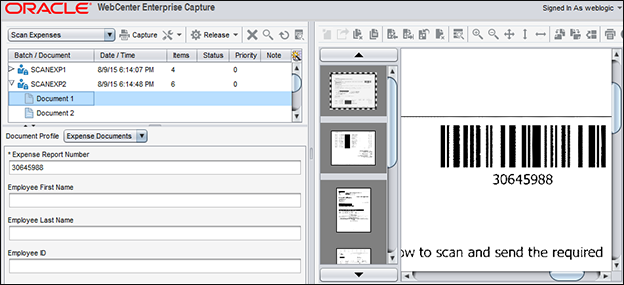
Description of "Figure 10-16 As a Client User, Viewing Recognition Processor Results (Document Separation and Metadata Field Population)"
-
10.2.9 Task 9: Configure Folder Import Processing
In this task, you configure an Import Processor job to import documents from a folder. In an expenses use case, employees may scan expense reports on an MFD to a network folder, and the Import Processor job monitors and imports from the folder at a specified time interval. (You can also configure email import, as described in Task 10: Configure Email Import Processing.)
To configure and verify this job's configuration, you will need a shared folder that contains expense report files (PDF or TIFF).
-
On the Capture tab, click the Add button in the Import Processor Jobs table.
-
Complete settings on the General Settings train stop.
-
In the Import Job Name field, enter a name (
Import From Folder). -
Deselect the Online field. (When you are ready for import processing to begin, you will change the job to online.)
-
In the Batch Prefix field, enter a prefix (
IMPFLDR). -
In the Import Source field, select Folder Source.
-
In the Import Frequency field, select Every 1 minute.
-
-
In the Image Settings train stop, optionally, you can select the Preserve image files option.
-
On the Document Profile train stop, select the Expenses Documents profile in the Default Document Profile field.
-
Complete settings on the Import Source Settings train stop.
-
In the Import Folder Path field, enter a path to the shared folder from which to import (for example,
\\FileServer\Expenses\Import). -
In the File Mask(s) field, enter the following to import PDF and TIFF files in the folder while bypassing all other files.
*.pdf; *.tif -
In the After Import options, select Delete file to prevent files from being reprocessed.
-
-
On the Post-Processing train stop, select Document Conversion Processor in the Batch Processor field and the Convert PDFs job in the Batch Processor Job field.
-
Click Submit. When ready, set the job's status to Online.
-
Verify the folder Import Processor job.
-
When ready to begin importing, ensure that there are PDF and/or TIFF files in the specified network folder. Select the job in the Import Processor Jobs table and click the Toggle Online/Offline button until the job's status changes to Online.
-
Start the client. Wait one minute for imported batches to display in the batch pane. If batches do not display, verify that Capture can access the shared folder you specified.
-
To stop importing, select the job in the Import Processor Jobs table and click the Toggle Online/Offline button until its status displays as Offline.
-
After batches are imported, they go to document conversion processing, then recognition processing. Click the Refresh Batch List icon, repeatedly if needed.
-
When the batch icon changes from processing to unlocked, expand the batch. You can see that the Recognition Processor job separated them into individual documents and populated the Expense Report Number field.
-
The final step in this use case is to activate the commit profile you set to offline earlier. On the Commit tab, select the profile and click the Toggle Online/Offline button until the profile's status changes to Online.
Based on the automated configuration, batches that do not encounter batch processor errors will enter Capture via the folder Import Processor job, undergo document conversion if applicable, then recognition processing, and finally commit processing. Batches that encounter errors will display in the client to exception specialists, who resolve and commit them.
-
10.2.10 Task 10: Configure Email Import Processing
In this task, configure how expenses attached to emails are imported and sent for processing. (You can also configure folder import, as described in Task 9: Configure Folder Import Processing.)
To verify this job's configuration, you will need an email inbox folder that contains email messages with attached expense report files (PDF or TIFF).
-
On the Capture tab, click the Add button in the Import Processor Jobs table.
-
Complete settings on the General Settings train stop.
-
In the Import Job Name field, enter a name (for example,
Import From Email). -
Deselect the Online field. (When you are ready for import processing to begin, you will change the job to online.)
-
In the Batch Prefix field, enter a prefix (
IMPEML). -
In the Import Source field, select Email Source.
-
In the Import Frequency field, select Every 30 seconds.
-
-
Select the Import Source Settings train stop and complete settings on the Email Accounts tab.
-
In the Email Server Name field, enter a DNS name or IP address (for example,
emailserver.example.com). -
In the IMAP Connection Security field, select the applicable security connection for the email server. If unknown, contact your email server administrator.
-
Click the Add button in the Email Accounts to Process table.
-
In the Email Address and Password fields of the Add/Edit Email Account window, enter an email address and password.
-
Click Verify to verify the address/password entry, then click OK.
Figure 10-17 Configuring Email Accounts From Which the Import Processor Will Import Email Messages and Attachments
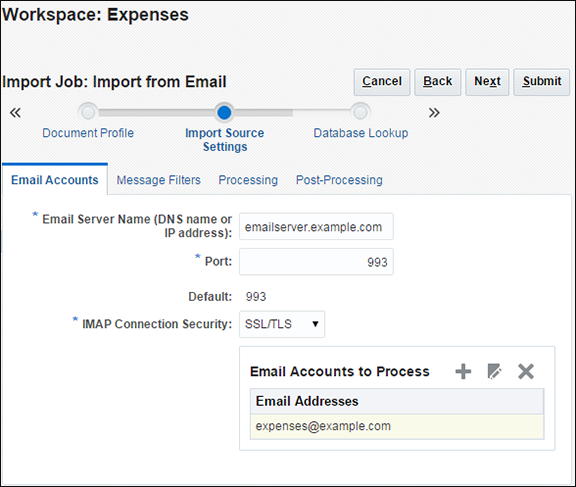
Description of "Figure 10-17 Configuring Email Accounts From Which the Import Processor Will Import Email Messages and Attachments"
-
-
On the Message Filters tab, specify the folder to process in the Folders to Process field.
For example, you might specify
inbox/expensesto import email messages stored in an expenses folder in the email inbox. The path delimiter may vary depending on the mail server used.Caution:
Be sure to specify a limited folder from which to import. Otherwise, Capture may attempt to process an entire inbox, which could result in unintended consequences.
-
On the Processing tab, optionally restrict the type of attachments to be imported.
By default, the Include attachments matching these mask(s) field is set to
*.*(all attachments are imported). To restrict import to certain file types, enter their extensions. For example, enter*.TIF;*.PDFto import all email attachments with a TIF or PDF extension. -
On the Post-Processing tab, select Document Conversion Processor in the Batch Processor field and the Convert PDFs job in the Batch Processor Job field.
-
Click Submit to complete creating the email Import Processor job.
-
Verify the email Import Processor job.
-
When ready to begin importing, ensure there are email messages with attached TIFF or PDF documents in the specified inbox folder. Select the job in the Import Processor Jobs table and click the Toggle Online/Offline button until the job's status changes to Online.
-
Start the client. Wait at least a minute for imported batches to display in the batch pane. If they do not appear, check the server's log file for any errors during processing.
-
To stop importing, select the job in the Import Processor Jobs table and click the Toggle Online/Offline button until its status displays as Offline.
-
After batches are imported, they go to document conversion processing, then recognition processing. Click the Refresh Batch List icon, repeatedly if needed.
-
When the batch icon changes from processing to unlocked, expand the batch. You can see that the Recognition Processor job separated them into individual documents and populated the Expense Report Number field.
-
-
The final step in this use case is to activate the commit profile you set to offline earlier. On the Commit tab, select the profile and click the Toggle Online/Offline button until the profile's status changes to Online.
Based on the automated configuration, batches that do not encounter batch processor errors will enter Capture via the email Import Processor job, undergo document conversion if applicable, then recognition processing, and finally commit processing. Batches that encounter errors will display in the client to exception specialists, who resolve and commit them.
10.2.11 Task 11: Configure Exception Handling
In the expenses scenario, errors can occur at several points.
-
Import Processor: The email or folder Import Processor job could fail. For example, Capture may encounter errors connecting to or reading from a specified email inbox or network folder.
-
Document Conversion Processor: The conversion processor could encounter a format that it does not recognize.
-
Recognition Processor: The processor might not be able to read a bar code due to a quality issue.
-
Commit Processor: Committing might fail if Capture encounters errors connecting to and writing to a shared network folder. Or, if a batch contains a document in which a required metadata field is blank, the batch does not commit and an error results.
To configure exception handling for an expenses scenario:
-
Optionally set a qualified user to be notified of Document Conversion Processor errors.
-
On the Processing tab, edit the Document Conversion Processor job.
-
On the Post-Processing train stop, enter the qualified user's address in the email notification field under When there are system errors options. Click Submit to save the Document Conversion Processor job.
-
-
Optionally set a qualified user to be notified of Recognition Processor errors.
-
On the Processing tab, edit the Recognition Processor job.
-
On the Post-Processing train stop, enter the qualified user's address in the email notification field under When there are system errors options. Click Submit to save the Recognition Processor job.
-
-
On the Capture tab, click the Add button in the Client Profiles table to add a client profile.
An exceptions specialist can use this profile to quickly view, index, and commit batches that encountered errors in their batch processing.
-
Select settings on the General Settings train stop.
-
In the Profile Type field, select 3 - Index Only.
-
In the Profile Name field, enter
Handle Exceptions.
-
-
On the Batch Filter Settings train stop, select Error in the Processing States field.
-
Figure 10-18 Configuring an Exceptions Client Profile to Display Error Batches Only
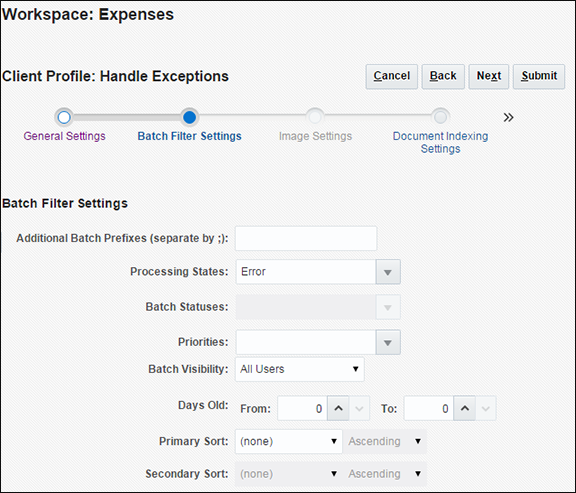
Description of "Figure 10-18 Configuring an Exceptions Client Profile to Display Error Batches Only"
-
-
On the Document Indexing Settings train stop, select your Expense Documents profile in the Document Profiles field.
-
On the Security train stop, assign a qualified user access to this profile.
-
On the Post-Processing train stop, click Add in the Available Release Processes table to add a release process. In the Release Process Settings window, enter a name for the release process and select Commit Processor in the Batch Processor field. This will allow the exception handler to manually complete batches and then commit them.
-
Click Submit to save the client profile.
-
Start up the client and log in as the user to whom you granted security access in step 7. Select the Handle Exceptions client profile. Select batches with errors to index and edit, then release them for committing.
